Sex-Specific Relationship Between Serum Uric Acid and Risk of Stroke: A Dose-Response Meta-Analysis of Prospective Studies
- PMID: 28356280
- PMCID: PMC5533011
- DOI: 10.1161/JAHA.116.005042
Sex-Specific Relationship Between Serum Uric Acid and Risk of Stroke: A Dose-Response Meta-Analysis of Prospective Studies
Abstract
Background: Conflicting findings of the association between serum uric acid (UA) and stroke have been reported in both men and women, and it is unclear whether this association was different between men and women. We preformed this meta-analysis to assess the sex-specific effect of serum UA on the risk of stroke and its subtypes.
Methods and results: Prospective studies that reported sex-specific association of UA levels with stroke or reported in a certain sex were included. Dose-response relationships were assessed by the generalized least squares trend estimation, and summary effect estimates were evaluated with random-effect models. Subgroup and sensitivity analyses were performed to assess the potential sources of heterogeneity and the robustness of the pooled estimation. Altogether, 13 prospective studies were identified in this study. The summary of relative risks (95% CIs) of stroke for a 1-mg/dL increase in serum UA levels were 1.10 (1.05-1.14) for men and 1.11 (1.09-1.13) for women. There is no significant difference in the effect of UA on future stroke risk between men and women (Pinteraction=0.736). Subgroup analyses showed that the significant associations persisted in most stratifications, and sensitivity analyses according to various inclusion criteria yielded similar results. A nonlinear relationship was observed in men (Pnon-linearity<0.001), with risk increasing significantly from a UA of 6 mg/dL and more steeply at higher UA levels.
Conclusions: Elevated serum UA levels were significantly associated with modestly increased risk of stroke in both men and women and have similar adverse effects on development of stroke in both sexes.
Keywords: meta‐analysis; prospective studies; sex difference; stroke; uric acid.
© 2017 The Authors. Published on behalf of the American Heart Association, Inc., by Wiley Blackwell.
Figures

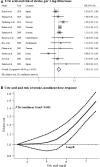

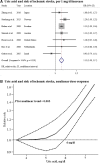
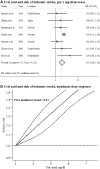
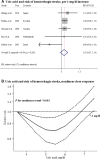
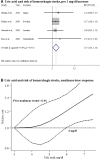
Similar articles
-
Associations between serum uric acid levels and the incidence of nonfatal stroke: a nationwide community-based cohort study.Clin Exp Nephrol. 2017 Jun;21(3):497-503. doi: 10.1007/s10157-016-1311-7. Epub 2016 Jul 12. Clin Exp Nephrol. 2017. PMID: 27405620
-
Uric acid and risk of myocardial infarction, stroke and congestive heart failure in 417,734 men and women in the Apolipoprotein MOrtality RISk study (AMORIS).J Intern Med. 2009 Dec;266(6):558-70. doi: 10.1111/j.1365-2796.2009.02133.x. Epub 2009 May 26. J Intern Med. 2009. PMID: 19563390
-
Serum uric acid concentrations and risk of intracerebral hemorrhage: A systematic review and meta-analysis.Atherosclerosis. 2018 Aug;275:352-358. doi: 10.1016/j.atherosclerosis.2018.07.002. Epub 2018 Jul 4. Atherosclerosis. 2018. PMID: 30015299
-
The relationship between serum uric acid and cognitive function in patients with chronic heart failure.BMC Cardiovasc Disord. 2020 Aug 20;20(1):381. doi: 10.1186/s12872-020-01666-z. BMC Cardiovasc Disord. 2020. PMID: 32819289 Free PMC article.
-
Hyperuricemia and coronary heart disease mortality: a meta-analysis of prospective cohort studies.BMC Cardiovasc Disord. 2016 Oct 28;16(1):207. doi: 10.1186/s12872-016-0379-z. BMC Cardiovasc Disord. 2016. PMID: 27793095 Free PMC article. Review.
Cited by
-
Serum uric acid and risk of stroke: a dose-response meta-analysis.J Clin Biochem Nutr. 2021 May;68(3):221-227. doi: 10.3164/jcbn.20-94. Epub 2020 Oct 13. J Clin Biochem Nutr. 2021. PMID: 34025024 Free PMC article.
-
Molecular genetic studies in Saudi population; identified variants from GWAS and meta-analysis in stroke.Saudi J Biol Sci. 2018 Jan;25(1):83-89. doi: 10.1016/j.sjbs.2017.08.014. Epub 2017 Aug 24. Saudi J Biol Sci. 2018. PMID: 29379361 Free PMC article.
-
Development and Internal Validation of a Risk Prediction Model for Carotid Atherosclerosis in the Hyperuricemia Population.Vasc Health Risk Manag. 2024 Apr 13;20:195-205. doi: 10.2147/VHRM.S445708. eCollection 2024. Vasc Health Risk Manag. 2024. PMID: 38633724 Free PMC article. Clinical Trial.
-
Hyperuricaemia Prevalence Rates According to Their Physiochemical and Epidemiological Diagnostic Criteria and Their Associations with Cardio-Renal-Metabolic Factors: SIMETAP-HU Study.J Clin Med. 2024 Aug 19;13(16):4884. doi: 10.3390/jcm13164884. J Clin Med. 2024. PMID: 39201026 Free PMC article.
-
Uric acid and neurological disease: a narrative review.Front Neurol. 2023 Jun 1;14:1164756. doi: 10.3389/fneur.2023.1164756. eCollection 2023. Front Neurol. 2023. PMID: 37333005 Free PMC article. Review.
References
-
- Gall SL, Donnan G, Dewey HM, Macdonell R, Sturm J, Gilligan A, Srikanth V, Thrift AG. Sex differences in presentation, severity, and management of stroke in a population‐based study. Neurology. 2010;74:975–981. - PubMed
-
- Chu NF, Wang DJ, Liou SH, Shieh SM. Relationship between hyperuricemia and other cardiovascular disease risk factors among adult males in Taiwan. Eur J Epidemiol. 2000;16:13–17. - PubMed
-
- Johnson RJ, Kang DH, Feig D, Kivlighn S, Kanellis J, Watanabe S, Tuttle KR, Rodriguez‐Iturbe B, Herrera‐Acosta J, Mazzali M. Is there a pathogenetic role for uric acid in hypertension and cardiovascular and renal disease? Hypertension. 2003;41:1183–1190. - PubMed
Publication types
MeSH terms
Substances
LinkOut - more resources
Full Text Sources
Other Literature Sources
Medical

